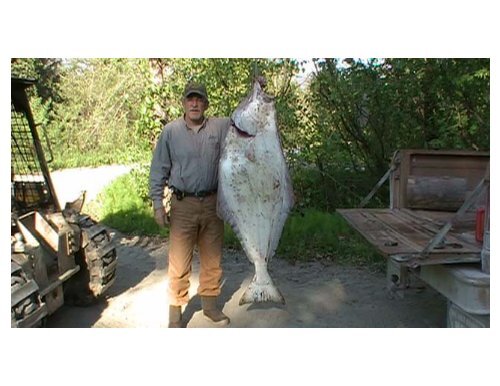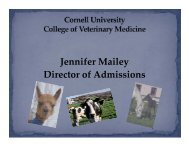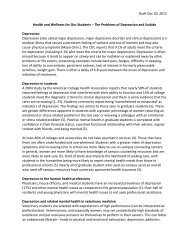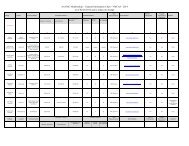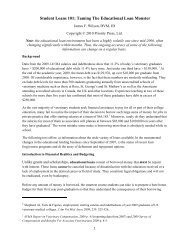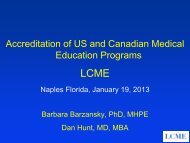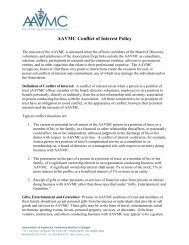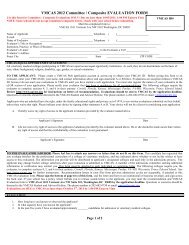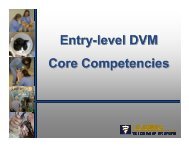Hedrick - AAVMC - Association of American Veterinary Medical ...
Hedrick - AAVMC - Association of American Veterinary Medical ...
Hedrick - AAVMC - Association of American Veterinary Medical ...
Create successful ePaper yourself
Turn your PDF publications into a flip-book with our unique Google optimized e-Paper software.
The National Board <strong>of</strong><br />
<strong>Veterinary</strong> <strong>Medical</strong> Examiners<br />
Dr. Jay <strong>Hedrick</strong>, Chair-Elect<br />
North <strong>American</strong> <strong>Veterinary</strong> <strong>Medical</strong> Education Consortium<br />
Las Vegas, Nevada<br />
July 15, 2010
The National Board <strong>of</strong><br />
<strong>Veterinary</strong> <strong>Medical</strong> Examiners<br />
• Formed by the AVMA in the late 1940’s<br />
• Reorganized and renamed the National Board<br />
Examination Committee in 1978<br />
• Incorporated in 1994 as an independent not for<br />
pr<strong>of</strong>it corporation, 501(c)(3)<br />
• Separated from the AVMA in December 1995<br />
• 13 members, directly appointed by constituent<br />
groups<br />
• Office in Bismarck, North Dakota since 1997<br />
• www.nbvme.org
NBVME Membership<br />
2009-2010<br />
• AAVSB: Meg Glattly, Jay <strong>Hedrick</strong>, Lila Miller,<br />
Joyceanne Fick (public member)<br />
• AAHA: Dennis Feinberg and Mike Thomas<br />
• AABP: Tom Hairgrove<br />
• AAEP: Ben Franklin<br />
• AASV: Rick Tubbs<br />
• <strong>AAVMC</strong>: Linda Blythe<br />
• AVMA COE: Jayne Jensen<br />
• Canadian NEB: Sylvie Latour<br />
• NAFV: Gary Gackstetter<br />
• Executive Director: John R. Boyce
NBVME Mission<br />
The NBVME is a nonpr<strong>of</strong>it, pr<strong>of</strong>essional veterinary<br />
examination service that provides psychometrically<br />
sound, defensible examinations for use by<br />
governmental licensing agencies and other entities<br />
so that they can assure the protection <strong>of</strong> public and<br />
animal health and welfare by assessing pr<strong>of</strong>essional<br />
competency.
NBVME Strategic Plan<br />
• 2007-2010 Goals:<br />
• Assure continuous improvement <strong>of</strong> assessment<br />
instruments<br />
• Increase organizational effectiveness in order to<br />
ensure and sustain the NBVME mission<br />
• Maintain i a financially i stable organization that t<br />
will ensure and sustain the NBVME mission<br />
• Develop programs for outreach to other<br />
organizations<br />
• 2010-2013 plan update underway
NBVME Meetings<br />
• Board meetings in January and July<br />
• NAVLE form review in April<br />
• Other activities as necessary:<br />
• Licensing board and other outreach visits<br />
• NAVLE and QE item bank reviews<br />
• NAVLE and QE standard setting exercises<br />
• Irregular behavior hearings<br />
• Job analysis task forces<br />
• Item writing
NBVME Examinations<br />
• North <strong>American</strong> <strong>Veterinary</strong> Licensing Examination<br />
(NAVLE®)<br />
• NAVLE Self-Assessments<br />
• Qualifying i Examination (QE)<br />
• <strong>Veterinary</strong> Clinical Skills Assessment (VCSA)<br />
• Species Specific Examinations<br />
The NAVLE the NAVLE Self-Assessments and the<br />
The NAVLE, the NAVLE Self Assessments, and the<br />
QE are developed by the NBVME in cooperation<br />
with the National Board <strong>of</strong> <strong>Medical</strong> Examiners<br />
(NBME) in Philadelphia, PA
NAVLE ® Process Overview<br />
A complex process to support a critical need…
NAVLE<br />
• 360-item computer-based multiple choice<br />
examination<br />
• First <strong>of</strong>fered in fall 2000<br />
• Replaced both the National Board Examination<br />
(NBE) and Clinical Competency Test (CCT)<br />
• Focuses on entry-level private clinical practice<br />
• 300 scored items and 60 pretest items<br />
• Includes pictorial items<br />
• Most items are case-based<br />
• French forms developed for use in Canada
Sample NAVLE Item<br />
A 2-year old Quarter horse is being evaluated<br />
because <strong>of</strong> pyrexia, anorexia, and depression. Clinical<br />
examination shows a bilateral nasal discharge and<br />
retropharyngeal swelling. Which <strong>of</strong> the following is the<br />
most likely diagnosis?<br />
(A) Esophageal obstruction<br />
(B) Equine influenza<br />
(C) Equine viral rhinopneumonitis<br />
(D) Guttural pouch mycosis<br />
(E) Strangles
NAVLE Job Analysis<br />
• Defines job activities <strong>of</strong> entry-level practitioners<br />
• Advisory Committee and practitioner survey<br />
• Examination forms administered through April<br />
2011 are based on a job analysis approved in<br />
2003-2004<br />
• New job analysis completed in 2009 will be used<br />
to develop examination forms given beginning in<br />
2011<br />
• NAVLE Test Blueprint: Activities, Species,<br />
Diagnoses
NAVLE Test Blueprint: Activities<br />
• Data Gathering and Interpretation (140 items; 47%)<br />
• e.g. Determine the status <strong>of</strong> the animal by observation<br />
and physical examination<br />
• Health Maintenance and Problem Management (140<br />
items; 47%)<br />
• e.g. Monitor the effectiveness <strong>of</strong> preventive and/or<br />
therapeutic measures<br />
• Pr<strong>of</strong>essional Behavior, Communications, and Practice<br />
Management (20 items; 6%)<br />
• e.g. Adhere to regulations regarding the veterinarian-<br />
client-patient relationship
NAVLE Test Blueprint: Species<br />
• Canine (70 items; 23%) • Cervidae (2 items; 1%)<br />
• Feline (68 items; 23%)<br />
• Pet Birds (10 items; 3%)<br />
• Other Small Animals<br />
(10 items; 3%)<br />
• Bovine (45 items; 15%)<br />
• Porcine (17 items; 6%)<br />
• Ovine/Caprine (10 items;<br />
3%)<br />
• Equine (47 items; 16%)<br />
• Camelidae (2 items; 1%)<br />
• Poultry (6 items; 2%)<br />
• Public Health (10 items;<br />
3%)<br />
• Non-species Specific<br />
(3 items; 1%)
NAVLE Test Blueprint:<br />
Diagnoses<br />
• 1,418 individual diagnoses, grouped by 11 animal<br />
species and 14 organ systems<br />
• Systems includes infectious, behavior, and multi-<br />
systems<br />
• e.g. Canine/Integumentary/Pyoderma<br />
• e.g. Bovine/Reproductive/Abortion<br />
• e.g. Feline/Behavior/Inappropriate elimination
NAVLE Security<br />
• item writer and reviewer confidentiality<br />
agreements<br />
• in-house security at NBME headquarters in<br />
Philadelphia<br />
• security at Prometric testing centers<br />
• candidate confidentiality statement<br />
• multiple examination forms<br />
• scrambled items<br />
• irregular behavior investigations
Examination Development elopment<br />
Advisory Board (EDAB)<br />
• Canine: Julie Fixman and Darcy Shaw<br />
• Feline: Susan Little and Helen Tuzio<br />
• Bovine: Mark Hilton and Norman LaFaunce<br />
• Equine: Benjamin Darien and Patricia Provost<br />
• Porcine: Karen Lehe<br />
• Public Health: Dale Boyle
NAVLE Item Writers<br />
• Approximately 25 item writers per year<br />
• Selected by EDAB members<br />
• Academicians and private practitioners<br />
• Item Writing Workshop for all new item writers<br />
• Asked to submit 40 items each<br />
• $1500 honorarium
NAVLE Item Review<br />
• Each year in November<br />
• Newly written items are reviewed by teams <strong>of</strong> item<br />
writers, by content area, with assistance from<br />
NBME editorial i staff<br />
• All images are reviewed for quality<br />
• New items are approved for addition to the NAVLE<br />
item bank
NAVLE Form Review<br />
• Each year in April<br />
• NBVME members, EDAB members, AAVSB<br />
representatives, and recent graduates review and<br />
approve all NAVLE forms to be given in the<br />
upcoming fall-spring testing cycle<br />
• Review is done by examination form, across all<br />
content areas
NAVLE Administration<br />
• The NAVLE is given at Prometric Testing Centers<br />
in the US, US Territories, and Canada<br />
• Overseas testing is available at Prometric centers<br />
in countries where there is an accredited<br />
d<br />
veterinary school, for an additional fee<br />
• Four week testing window in November-December<br />
• Two week testing window in April
NAVLE Standard Setting<br />
• The present content-based passing standard was<br />
approved by the NBVME in January 2009,<br />
following a July 2008 workshop<br />
• The passing standard is reviewed and approved<br />
each January by the NBVME Executive<br />
Committee<br />
• The passing standard is expressed as 425 on a<br />
200-800 scale<br />
• All licensing boards in North America accept the<br />
• All licensing boards in North America accept the<br />
same passing standard
NAVLE Score Reporting<br />
• Scores are reported to licensing boards and<br />
AAVSB/VIVA approximately 30 days after the<br />
close <strong>of</strong> each testing ti window<br />
• Failing candidates receive a diagnostic report<br />
• Accredited veterinary schools receive interim<br />
school score reports in February, and summary<br />
school score reports in August<br />
• Following each testing window, accredited<br />
veterinary schools receive individual candidate<br />
scores, for candidates who consent
NAVLE Statistics<br />
• 18 administrations from fall 2000 - April 2010<br />
• 42,473473 candidates to date<br />
• Overall passing rate at graduation for accredited<br />
school graduates: 95-98%<br />
• Good correlation between NAVLE score and class<br />
rank<br />
• Little or no correlation between score and class<br />
focus<br />
• Detailed NAVLE Technical Reports at nbvme.org
NAVLE Letter <strong>of</strong> Agreement<br />
• Negotiated annually with each licensing board and<br />
the Canadian NEB<br />
• Specifies details regarding eligibility, fees,<br />
deadlines, dli application procedures, score reporting,<br />
test accommodations, and irregular behavior<br />
• For 2010-11, NBVME <strong>of</strong>fice will handle NAVLE<br />
approvals for 21 states: CO, FL, IN, IA, ME, MD,<br />
MI, MN, ME, NV, NH, NJ, NY, NC, OR, PA, SC,<br />
TX, UT, VT, and VA
NAVLE Self-Assessments<br />
• 200-item web-based examinations using retired<br />
NAVLE items<br />
• Two forms <strong>of</strong> each examination, in English and<br />
French (third English form will be available fall<br />
2010)<br />
• $50 each<br />
• Candidates receive score feedback reports with<br />
predicted NAVLE performance<br />
• Available through nbvme.org since January 2008
Qualifying Examination (QE)<br />
• 300-item web-based basic science examination<br />
covering anatomy, physiology, pharmacology,<br />
microbiology, and pathology<br />
• Required for PAVE step 3<br />
• Administered in September, January, and May<br />
• 2,216 PAVE QE candidates since 2002<br />
• Average pass rate for PAVE candidates is 78%<br />
• Since 2005, 1,332 candidates at four accredited<br />
schools (Western, Iowa State, Tuskegee, and<br />
Minnesota) have taken the QE as a measure <strong>of</strong> basic<br />
science knowledge<br />
science knowledge<br />
• Detailed QE Technical Reports at nbvme.org
<strong>Veterinary</strong> Clinical Skills<br />
Assessment (VCSA)<br />
• Two-day hands-on practical examination<br />
• Step 4 option for PAVE candidates<br />
• Given at Cedar Valley College in Dallas, TX<br />
• 42 PAVE VCSA candidates since 2005, plus 19<br />
reference candidates<br />
I l d f li i l t th t l t<br />
• Includes four clinical encounters that evaluate<br />
communication skills using standardized clients
Foreign Graduate Certification<br />
ECFVG<br />
PAVE<br />
Sponsor AVMA AAVSB<br />
Acceptance<br />
All boards (and<br />
Canada)<br />
33 boards (in addition to<br />
ECFVG)<br />
Step 1 Credentials Credentials<br />
Step 2 English pr<strong>of</strong>iciency English pr<strong>of</strong>iciency<br />
Step 3 BCSE QE<br />
Step 4 CPE Clinical year or VCSA<br />
Licensure NAVLE NAVLE
Species Specific Examinations<br />
• 100-item paper and pencil examinations<br />
• Based on retired dNAVLEit items, but ttailored dto<br />
experienced practitioners rather than entry-level<br />
• Companion animal and equine versions<br />
• Two forms <strong>of</strong> each examination<br />
• Revised in 2007<br />
• Available to licensing i boards on demand d
Acronyms<br />
NBVME: National Board <strong>of</strong> <strong>Veterinary</strong> <strong>Medical</strong> Examiners,<br />
Bismarck, ND<br />
EDAB: Examination Development Advisory Board (NBVME)<br />
NAVLE: North <strong>American</strong> <strong>Veterinary</strong> Licensing Examination<br />
(NBVME)<br />
QE: Qualifying Examination (NBVME)<br />
VCSA: <strong>Veterinary</strong> Clinical Skills Assessment (NBVME)<br />
NBE: National Board Examination (NBVME)<br />
CCT: Clinical Competency Test (NBVME)<br />
NBME: National Board <strong>of</strong> <strong>Medical</strong> Examiners, Philadelphia,<br />
PA
Acronyms<br />
NEB: Canadian National Examining i Board, Ottawa, ON<br />
AAVSB: <strong>American</strong> <strong>Association</strong> <strong>of</strong> <strong>Veterinary</strong> State Boards,<br />
Kansas City, MO<br />
PAVE: Program for the Assessment <strong>of</strong> <strong>Veterinary</strong> Education<br />
Equivalence (AAVSB)<br />
AVMA: <strong>American</strong> <strong>Veterinary</strong> <strong>Medical</strong> <strong>Association</strong>,<br />
Schaumburg, IL<br />
ECFVG: Educational Commission for Foreign <strong>Veterinary</strong><br />
Graduates (AVMA)<br />
BCSE: Basic and Clinical Sciences Examination (ECFVG)<br />
CPE: Clinical Pr<strong>of</strong>iciency Examination (ECFVG)


